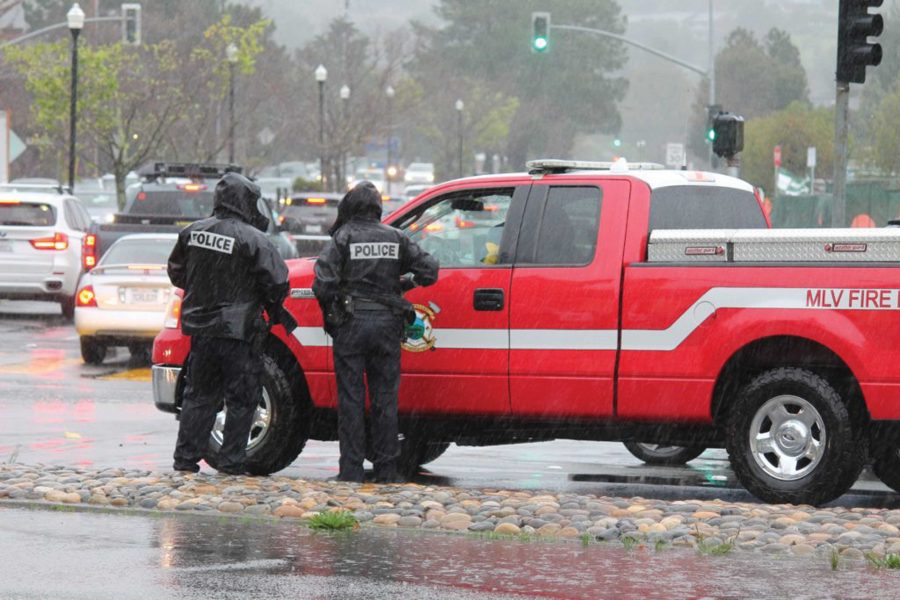When king tides and heavy rain combined to caused flooding and road closures in January, it came as no surprise to residents of Mill Valley.
“The flooding goes back for as long as we’ve recorded the information,” said former editor of the Historical Society Review and long time Mill Valley resident Joan Murray, who wrote an article about the history of Mill Valley flooding for the review in 2006.
AP environmental science teacher John Ginsburg attributed flooding to a combination of floodplains, tides, and periods of heavy rainfall.
“[Along with the floodplain] we’re dealing with tides, and the flooding is always at its worst when we have our highest tides, king tides. And so the worst scenario is for extremely heavy rains at the same time we have extremely high tides,” Ginsburg said. This January there were several instances of flooding caused by a combination of king tides and rain.
Flooding frequently results in road closures and damage to property. Although road closures are sure to exacerbate traffic issues, they’re often necessary in order to protect drivers from the dangerous driving conditions flooding creates.
Mill Valley city government directs large amounts of resources and attention to addressing flooding, and several improvements in flood prevention and protocol have been made in response to major flooding in the 1950s, 1980s, and mid-2000s. These include the construction or flood prevention infrastructure, sandbag availability, and the creation of email and text based flood alerts.
According to Mill Valley zone engineer Scott McMorrow, concrete and earthen channels were constructed in the 1960s in order to prevent flooding in the Coyote Creek area.
“Prior to the [concrete and earthen channels] being built, there was periodic flooding along Coyote Creek that impacted homes and businesses,” he said. “Subsequent to the building of this Project in the 1960s, many more homes and businesses have been built in Tam Valley. To date, there has been no significant flooding along Coyote Creek.”
These protections, combined with increased demand for housing in Mill Valley, have led to development in flood zone areas, putting larger areas of the town at risk .
“We’ve put ourselves in a precarious position, because the natural cycle of those rivers is to jump out of the banks during heavy rains, and now we have put our own developments on those very banks,” Ginsburg said.
Both Ginsburg and Murray added that long term solutions to the flooding are unlikely.
“The fix that everyone is hoping can happen, you know, ‘why don’t they just build the road taller,’ or something like that, those are fixes that the cost is in the many billions of dollars kind of range [for the Bay Area],” Ginsburg said. “… And what you have to keep in mind is that if you’re going to try to keep out the bay, if you have any break in your levy or your pump stations or your higher roads or whatever, it doesn’t take much for a little crack in that system, in that fix, to get opened up.”
Murray said residents often expect that more can be done than is possible. These false expectations provided the impetus for her article of the history of flooding in Mill Valley.
“I was concerned that we have a lot of new residents who had no idea that we have had a history of flooding,” Murray said. “And they seemed to expect that the city was going to take care of everything, and that’s just not possible.”
Flooding doesn’t just affect the commutes of students. According to Murray, it often prevents public works employees, many of whom live outside of Mill Valley, from getting to work.
“At one time, our public works people lived in town, and if there was a problem, they came,” Murray said. “Now, of course, we have firefighters that are on duty all the time, and we may have police officers on duty, but that’s it. And those people, they don’t live here. The public works people don’t live here, and so getting them here, and through potentially flooded areas… sometimes they can’t even get here.”
With climate change advancing, the flooding is expected to get worse.
“As you increase ocean waters you increase evaporation, and that inputs more moisture in the air and that inputs more precipitation,” Ginsburg said. “And then, if you have higher tides, because the water level has come up in the bay, you’re combining, that’s a double whammy. You’re getting extra rain and extra high tides simultaneously. That’s going to lead to more flooding.”
“[The city is] doing the best the can, and there’s a lot more focus by the city on flooding,” Murray said. “But there are going to be things that homeowners are just going to have to come to grips with, like, they live in a floodplain.”



